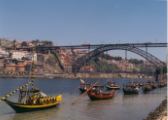About Porto
Some Porto Links
- Official Porto Tourism Website
- Porto @ Wikipedia
- Porto @ Wikitravel
- Porto @ Tripadvisor
- Go Porto Tourism Guide
- porto-tourism.com
The city of Porto
 This gracious capital of
the north is Portugal's second largest city and one of the most
beautiful in Europe.
This gracious capital of
the north is Portugal's second largest city and one of the most
beautiful in Europe.
Rich from centuries of trade, modern Porto is as much a cosmopolitan centre as it is a city steeped in the historical events of the past. Being built on the slopes of the steep hills that overlook the River Douro, Porto has a truly unique appearance and its historic centre has already been classified by UNESCO as a World Heritage site. The 'granite city' is also known for its striking bridges and the much celebrated Port wine, which is stored and savoured by wine lovers all over the world.
 In 2001, Porto was an European Cultural
Capital (together with Roterdam), but every year the events
held in this city bring together thousands of people. Amongst
the city´s most important events are Fantasporto (an
International Festival of Science Fiction and Fantasy Films),
held in February/March and the city´s popular festivities held
in June in honour of St. John the Baptist. Porto's most
important cultural buildings are perhaps the a new House of
Music, idealized by Rem Koolhaas, and "Museu de Serralves", a
very nice Museum of Modern Art.
In 2001, Porto was an European Cultural
Capital (together with Roterdam), but every year the events
held in this city bring together thousands of people. Amongst
the city´s most important events are Fantasporto (an
International Festival of Science Fiction and Fantasy Films),
held in February/March and the city´s popular festivities held
in June in honour of St. John the Baptist. Porto's most
important cultural buildings are perhaps the a new House of
Music, idealized by Rem Koolhaas, and "Museu de Serralves", a
very nice Museum of Modern Art.
Brief history of the city
In the area where the Douro river ran through, existed a village called Cale (V Century). Later it is referred as Portus Cale and Portucale, the origin of the country´s name. When Vímara Peres repopulates this area in the IX Century, Portucale also designates the territory dependente on it and in the X Century the whole area south of the River Lima.
 In the XIV Century the city receives a
new mural. Though designated as Fernandina, its construction
must have happened between the reigns of D. Afonso IV and
D. João I. This fortification defines the historic nucleus of
Porto.
In the XIV Century the city receives a
new mural. Though designated as Fernandina, its construction
must have happened between the reigns of D. Afonso IV and
D. João I. This fortification defines the historic nucleus of
Porto.
In the end of the XV Century Porto had only one parish and its population didn´t go beyond the 10 000 inhabitants (far less than Lisbon, which had about 50 000). However, in the XVII Century Porto knows an important growth due to the wine commerce. The signature of the Methuen Treaty (1703) favours the exportation of wines to Great Britain and then creates the Royal Company of Wine Agriculture of the High Douro ("Real Companhia da Agricultura dos Vinhos do Alto Douro").
 Another period of the urban history of
Porto happens in the XIX Century with the Industrial
Revolution. Many factories settle down in the city,
bourgeoisie neighborhoods are built and avenues are
opened. Porto becomes a commercial and industrial city, with
the parish of Massarelos as its center. In this place, that
began as the center of the salt production in the XIII
Century, foundries, millings and the first thermal center of
town are built. In 1855 public lighting was inaugurated and in
1865 the Crystal Palace (picture on the right) is inaugurated.
Another period of the urban history of
Porto happens in the XIX Century with the Industrial
Revolution. Many factories settle down in the city,
bourgeoisie neighborhoods are built and avenues are
opened. Porto becomes a commercial and industrial city, with
the parish of Massarelos as its center. In this place, that
began as the center of the salt production in the XIII
Century, foundries, millings and the first thermal center of
town are built. In 1855 public lighting was inaugurated and in
1865 the Crystal Palace (picture on the right) is inaugurated.
The development of a city cannot happen without transportation and the River Douro was an obstacle that was only surpassed with the technical progress of the XIX Century. After some less important bridges, in 1877 was built the D. Maria bridge (for trains) and in 1886 is inaugurated the D. Luis bridge, by Gustav Eiffel, one of the ex-libris of the city. Nowadays Porto has 5 bridges crossing the river, and 2 more are being built.
 The 20th century brought even more
development to Porto. The renovation of the center begins,
with opening of the Aliados's Avenue and the new Town House,
and the also the beautiful São Bento Train Station
(inaugurated in 1909). The University grows (it is now
Portugal biggest academy) and its economy boosts. Today, Porto
is a thriving industrial centre (textiles, clothing, shoes and
leather goods, beverages and food processing, printing and
publishing, and chemicals).
The 20th century brought even more
development to Porto. The renovation of the center begins,
with opening of the Aliados's Avenue and the new Town House,
and the also the beautiful São Bento Train Station
(inaugurated in 1909). The University grows (it is now
Portugal biggest academy) and its economy boosts. Today, Porto
is a thriving industrial centre (textiles, clothing, shoes and
leather goods, beverages and food processing, printing and
publishing, and chemicals).


